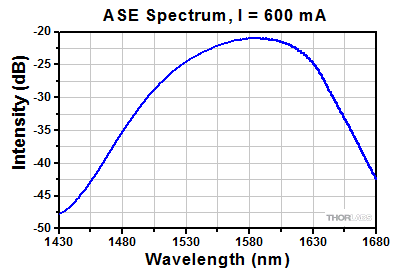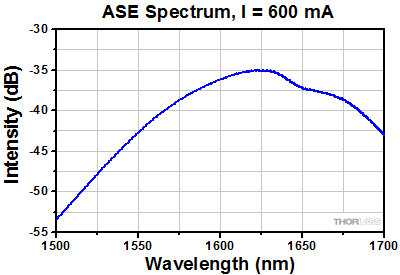
L-Band Booster Optical Amplifiers (BOAs), 1590 - 1625 nm
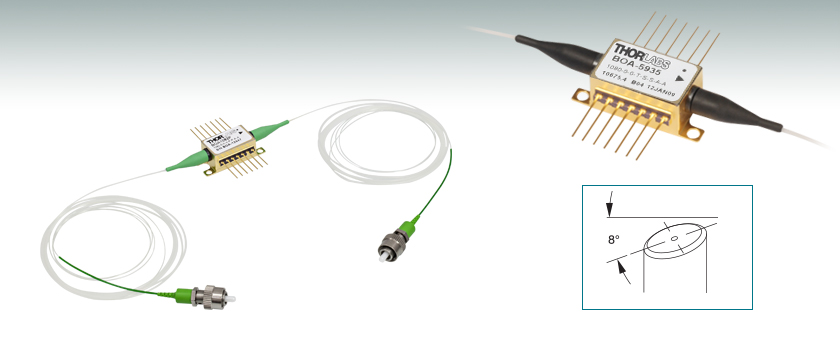
- Polarization-Dependent Booster Optical Amplifiers
- SM or PM Fiber-Pigtailed Butterfly Package
- L-Band and Super L-Band BOAs Available
BOA1082P
FC/APC Connectors
OVERVIEW
| Optical Amplifier Selection Guide |
|---|
| 780 - 795 nm BOAs |
| 830 nm BOAs |
| 930 nm BOAs |
| 980 nm BOAs |
| 1050 nm BOAs |
| 1210 nm BOAs |
| 1250 nm BOAs |
| O-Band (1280 - 1350 nm) BOAs |
| E-Band (1410 nm) BOAs |
| C-Band (1520 - 1550 nm) BOAs and SOAs |
| L-Band (1590 - 1625 nm) BOAs |
| 1685 nm BOAs |
| 1700 nm BOAs |
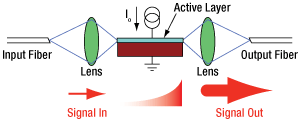
Click to Enlarge
Figure 1.1 When current is applied across the ridge waveguide, excited state electrons are stimulated by input light, leading to photon replication and signal gain.
Features
- L-Band and Super L-Band
- Polarization Maintaining: Amplifies Only One Polarization State
- Available with Either SM or PM Fiber Pigtails (1.5 m), 2.5 dB Loss at Each End of Chip
- FC/APC Connectors
- High Saturation Power, High Efficiency
- 3 dB Bandwidth: 80 nm or 90 nm (Typical)
- AR-Coated End Faces on Chip (R < 0.1%)
- Typical Applications: Boosting Laser Transmitters, Compensating for Transmit MUX/DeMUX Insertion Loss, Optical Shutter
Booster Optical Amplifiers (BOAs) are single-pass, traveling-wave amplifiers that perform well with both monochromatic and multi-wavelength signals. Since BOAs only amplify one state of polarization, they are best suited for applications where the input polarization of the light is known. For applications where the input polarization is unknown or fluctuates, a Semiconductor Optical Amplifier (SOA) is required. However, the gain, noise, bandwidth, and saturation power specifications of a BOA are superior to that of a SOA because of the design features that make the SOA polarization insensitive.
The BOA consists of a highly efficient InP/InGaAsP Multiple Quantum Well (MQW) layer structure. As seen in Figure 1.1, the input and output of the amplifier is coupled to the reliable ridge waveguide on the optical amplifier chip. Losses typically range from 1.5 to 2.5 dB for the fiber-to-chip and chip-to-fiber coupling (each). These coupling losses affect the total gain, noise figure (NF), and saturation power (Psat). While the gain produced by the amplifier exceeds that of the losses, these losses remain an important factor in determining the device's performance. For instance a 1 dB drop in input coupling efficiency increases the noise figure by 1 dB. Alternatively, a 1 dB drop in output coupling decreases the saturation power by 1 dB.

Click to Enlarge
Figure 1.2 Our BOA1080P and BOA1082P optical amplifiers are also available in the S9FC1080P and S9FC1082P benchtop optical amplifiers, respectively.
The device is contained in a standard 14-pin butterfly package with either SMF or PMF pigtails that are terminated with FC/APC connectors. The connector key is aligned to the slow axis on all PMF pigtailed models. Optional polarization-maintaining isolators at the input, output, or both input/output are also available (specifications may vary with different configurations). Please contact Tech Support to order such a device.
Mount and Driver Options
These butterfly packages are compatible with the CLD1015 laser diode mount with integrated controller and TEC. When operating the BOAs on this page with the CLD1015, the orientation for type 1 pin configurations should be used. They are also compatible with the LM14TS and LM14S2 mounts, which can be used with our laser diode, TEC, and combined current/TEC controllers. When operating these lasers in environments with more than 5 °C variation in temperature, we recommend using the LM14TS mount, which provides active control of the butterfly package's case temperature to stabilize the amplifier's output wavelength and power.
Center Wavelength Note
The center wavelength (CWL) of the ASE spectrum in broadband semiconductor devices such as optical amplifiers may show variation between lots. Please refer to the Specs tab for the CWL tolerances of each particular model. For applications in which a specific ASE center wavelength is a critical concern, please contact Tech Support for information on the CWL of currently available lots.
| Item #a | Center Wavelength | 3 dB Bandwidth | Saturated Output Power (@ -3 dB) |
Small Signal Gain (@ Pin = -20 dBm) |
Noise Figure |
|---|---|---|---|---|---|
| BOA1080S and BOA1080P | 1590 nm Typical | 90 nm Typical | 15 dBm Typical | 26 dB Typical | 7.0 dB Typical |
| BOA1082S and BOA1082P | 1625 nm Typical | 80 nm Typical | 13 dBm Typical | 18 dB Typical | 8.5 dB Typical |
SPECS
| Item # | Symbol | BOA1080S and BOA1080P | BOA1082S and BOA1082P | ||||
|---|---|---|---|---|---|---|---|
| Min | Typical | Max | Min | Typical | Max | ||
| Operating Current | IOP | - | 600 mA | 750 mA | - | 600 mA | 750 mA |
| Center Wavelength | λC | 1570 nm | 1590 nm | 1610 nm | 1600 nm | 1625 nm | 1650 nm |
| Optical 3 dB Bandwidth | BW | 80 nm | 90 nm | - | 70 nm | 80 nm | - |
| Saturation Output Powera (@ -3 dB) | PSAT | 12 dBm | 15 dBm | - | 10 dBm | 13 dBm | - |
| Small Signal Gain (@ Pin = -20 dBm, Typical λC) | G | 23 dB | 26 dB | - | 14 dB | 18 dB | - |
| Gain Ripple (RMS) @ IOP | δG | - | 0.05 dB | 0.2 dB | - | 0.05 dB | 0.3 dB |
| Noise Figure | NF | - | 7.0 dB | 9.0 dB | - | 8.5 dB | 9.5 dB |
| Forward Voltage | VF | - | 1.5 V | 2.0 V | - | 1.5 V | 2.0 V |
| Chip Length | - | - | 1.5 mm | - | - | 1.5 mm | - |
| Waveguide Refractive Index | - | - | 3.2 | - | - | 3.2 | - |
| TEC Operation (Typical/Max @ TCASE = 25/70 °C) | |||||||
| TEC Current | ITEC | - | 0.12 A | 1.5 A | - | 0.12 A | 1.5 A |
| TEC Voltage | VTEC | - | 0.25 V | 4.0 V | - | 0.25 V | 4.0 V |
| Thermistor Resistance | RTH | - | 10 kΩ | - | - | 10 kΩ | - |
PIN DIAGRAM

Mechanical Drawing and Pin Assignments
GRAPHS
Note: All plots illustrate typical performance, and individual units may have slightly different performance, within the parameters outlined on the Specs tab.
BOA1080S and BOA1080P Graphs
The gain vs. output power plot and the amplified spontaneous emission (ASE) spectrum plot for the BOA1080S and BOA1080P were measured with an input wavelength of 1590 nm and an operating current of 600 mA.
BOA1082S and BOA1082P Graphs
The gain vs. output power plot and the amplified spontaneous emission (ASE) spectrum plot for the BOA1082S and BOA1082P were measured with in an input wavelength of 1620 nm and an operating current of 600 mA.
OPTICAL AMPLIFIERS
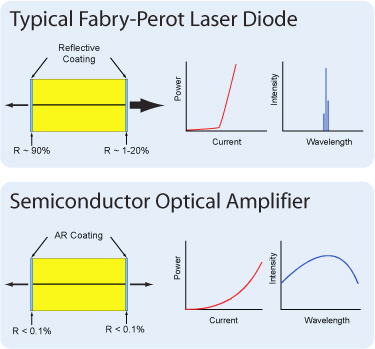
Booster optical amplifiers (BOAs) and semiconductor optical amplifiers (SOAs) are single-pass, traveling-wave amplifiers that perform well with both monochromatic and multi-wavelength signals. Since BOAs only amplify one state of polarization, they are best suited for applications where the input polarization of the light is known. For applications where the input polarization is unknown or fluctuates, a Semiconductor Optical Amplifier (SOA) is required. However, the gain, noise, bandwidth, and saturation power specifications of a BOA are superior to that of a SOA because of the design features that make the SOA polarization insensitive.
BOAs and SOAs are similar in design to Fabry-Perot Laser Diodes, the difference being that Fabry-Perot laser diodes have reflective coatings on both end faces of the semiconductor chip. The optical feedback from the reflective end faces establishes a cavity in which lasing can occur. SOAs and BOAs have an anti-reflection (AR) coating on both end faces of the semiconductor chip. The AR coatings limit the optical feedback into the chip so that lasing does not occur.
As is typical for all amplifiers, BOAs/SOAs operate in two regimes: a linear, flat, constant gain regime and a non-linear, saturated output regime. When used to amplify a modulated signal, the linear regime is typically used to eliminate pattern-dependent distortion, multi-channel cross-talk, and transient response issues common to EDFAs. The non-linear regime is used to take advantage of the highly non-linear attributes of the semiconductor gain medium (cross-gain modulation, cross phase modulation) to perform wavelength conversion, optical 3R regeneration, header recognition, and other high-speed optical signal processing functions.
For a continuous wave input signal, the amount of power that can be produced by the amplifier is determined by the saturation output power (Psat) parameter. Psat is defined as the output power at which the small-signal gain has been compressed by 3 dB. The maximum amount of CW power that can be extracted is approximately 3 dB higher than the saturation power.
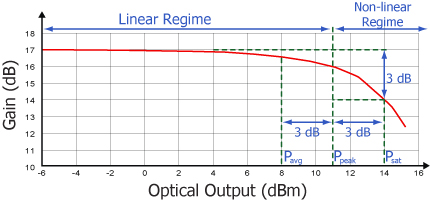
L-Band BOAs
Part Number | Description | Price | Availability |
|---|---|---|---|
BOA1080S | L-Band Booster Optical Amplifier, CWL=1590 nm (Typ.), Butterfly Pkg, SMF, FC/APC | $2,626.05 | Today |
BOA1080P | L-Band Booster Optical Amplifier, CWL=1590 nm (Typ.), Butterfly Pkg, PMF, FC/APC | $2,976.87 | Today |
Super L-Band BOAs
Part Number | Description | Price | Availability |
|---|---|---|---|
BOA1082S | Super L-Band Booster Opt. Amp., CWL=1625 nm (Typ.), Butterfly Pkg, SMF, FC/APC | $3,028.99 | Today |
BOA1082P | Super L-Band Booster Opt. Amp., CWL=1625 nm (Typ.), Butterfly Pkg, PMF, FC/APC | $3,379.80 | Today |


